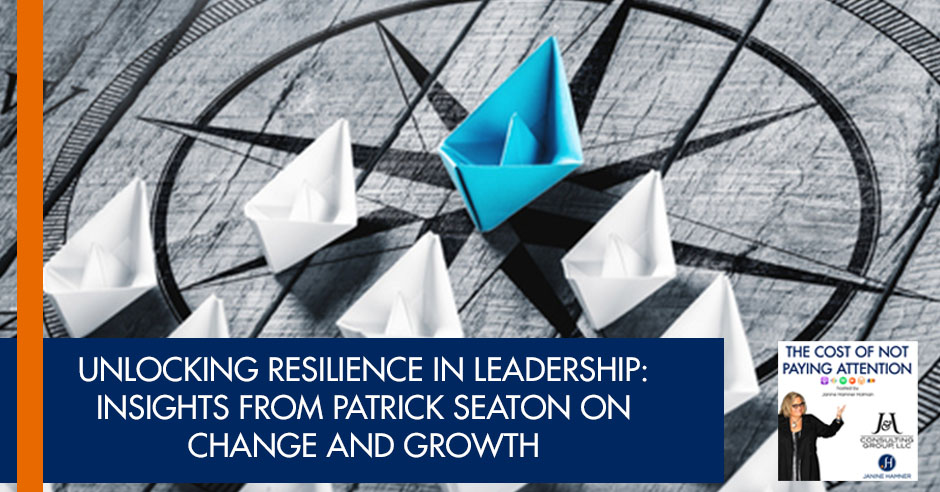
Leadership is not just about guiding others; it’s about navigating challenges with resilience and emerging stronger, especially in today’s ever-changing business landscape. Today, we explore how leaders can foster resilience within themselves and their teams. Our guest, Patrick Seaton, is a seasoned business leader. Patrick shares his insights on navigating challenges, adapting to change, and driving growth. He also dives into the importance of listening to your employees, creating a culture of open communication, and empowering middle management to drive success. If you want to discover how to bounce back from setbacks and inspire your team to persevere even in the face of adversity, you don’t want to miss this episode!
GUEST: Patrick Seaton | LinkedIn | Website
HOST: Janine Hamner Holman | Janine@JandJCG.com | LinkedIn, Facebook, and Instagram | Subscribe to my Newsletter! | Book me to Speak!
—
Listen to the podcast here
Unlocking Resilience In Leadership: Insights From Patrick Seaton On Change And Growth
Helping Middle Management and Frontline Supervisors
Patrick Seaton is a passionate believer in providing access to tools that help the people that are the glue of every company, the middle management and the frontline supervisors. While many people focus on the what and the why of doing things in a company, Patrick has dedicated over 28 years to the how in a way that connects strategy to execution. Through a suite of 28 different digital conversation frameworks that bring small groups of people together for collaboration, incremental progress, and improvements, he teaches companies how to address the elephants that are in every department of every company without relying on an outside consultant. I might have some problems with that last part because that’s what I do. Welcome to the show, Patrick.
Thank you, Janine. Welcome. I’m glad to be here with you. I’ll adjust the last thing you said first. Without relying on an external consultant, the things that I’ve been focused on over the years focus on the challenges, situations, and problems at the department level, as well as the frontline supervisor. I have tools that help at the organizational level, but the vast majority of them are department-level tools because that was what I did for seventeen years.
Let me explain why you wouldn’t want to do some of the things that I have tools for. For example, one of the conversation frameworks is about roles and responsibilities. You have a department, Department X, and you’re part of Department X. You say, “Everybody, in three months, I’m retiring.” Everyone says, “Janine, congratulations. I hope you have fun traveling the world.” That’s a situation. What do we need to do? We need to sit down as a department and have a conversation, saying, “What are we going to do when Janine leaves? What are we going to do with her work, her tasks?” We divvy it up. Are we going to hire a clone? Are we going to move things around? Whatever it is. You leave, you’re traveling the world. What happens? Two months later, someone gets promoted out.
We’re going to have to have the same conversation. Two months after that, we might have another hire coming. These are some of the conversation frameworks are around conversations that happen 5, 6, 7, 8 times a year in one department. Now, if you have 12 departments, are you going to do it 96 times? As a consultant, would you go into a company and want to do the exact same thing 96 times? No.
There are other topics, such as how well the senior leadership is aligned. Maybe we need to sit down and have a conversation about that because senior management is not going to open up that to an internal facilitator, but they will want to bring an external consultant in. The frameworks are such that there are some that are very much in the wheelhouse of consultants and coaches that they do annually or bi-annually or something.
When you get down into these other conversations that are almost weekly, a company should not hire or pay for an external consultant. I train the internal facilitators on how to champion and sponsor those topics and let the others go there. You will love the things I have, but not the things that that don’t fit with you and that you would have to do over and over. Let’s take that off the table.
It’s not a good piece of organizational resources to bring in an out outside consultant. If they’re having people retiring and moving up and moving around within the company, they need to have a plan and a process for how do we have those conversations? How do we think about the right way to either bring in talent from the outside or raise up talent from the inside, and what happens to those people’s roles? How are we doing succession planning within the organization, and then what are the nuts and bolts of how that happens?
That’s 1 of the 28 topics.
I am excited to get into the meat of this with you. In your work, either within your business or with your clients, but I think what we’re talking about is with your clients, what’s the one thing that you have realized that they have been failing to pay attention to, either consciously or unconsciously, and what’s the problem? What’s the cost of that inattention? What’s the problem that it’s causing?
That is the crux of my entire company.
That is why we’re here talking.
It is the mission of my company, which is to democratize the tools for the people who need them. What are they not listening to? Very often, they’re not listening and supporting the middle management and the frontline supervisors. It’s not that they don’t care about it but everybody has a different perspective when at the different altitudes of a company. If my role is senior manager, senior leader, let’s say I’m at the 50,000 foot level. That’s my world. That’s what I see. I have a staff of middle managers, then supervisors, and then the employees. The worst thing I could do was actually go and try to play down at the 50-foot level because then I would not be doing my job. The thing is, just because I don’t see it at my altitude doesn’t mean that it doesn’t exist.
This is a problem that so many organizations are facing, and we have data from organizations from Gallup to Deloitte to pwc that say that the challenges that leadership sees, or the way that leadership in an organization thinks about the organization is very much not the way that rank and file or frontline managers or middle-level supervisors see things. There’s a real disconnect.
The senior management, the leadership, are very much focused on the what and the why. They’re the strategic people. That’s not to say that departments can’t have strategies and all that stuff, but and in general terms, that’s their thing. However, when you bring it down to the department level, you have to get into the what and the how. The individual contributor is very much in the daily how They keep the machine running. The three wheelhouses, if you will, that I see in organizations, and all of the conversation frameworks fit into these, are people, process and planning.
Every single department of every single company has people or department. They have processes that are constantly evolving. They have new projects that always need planning. Those three wheels are constantly moving. How we deal with those situations or the conversations that come from those based on those three wheelhouses is the work of the department manager and department supervisor. It’s not so much at the top leadership level that they’re saying, “How’s this process going to work?”
They better not be.
Some do and that was my worst boss ever. He was my best worst because he taught me what not to do. They’re putting the objective out there. This is where we’re going. The levels below are doing the day-to-day work. They know it works and they know it doesn’t work. The further you go down into the organization, they even know more. They are the experts. What are companies not doing? They’re not listening to the experts. Partly because they’re like, “That’s too much detail for me.” Okay, fine. You don’t need to be involved in all the detail, but what you do need to do as a leader is support them, give them access to tools, coaching and what they need so that from their perspective and their altitude in the company, they can actually do it the best way possible.
As a leader, you need to support your people. Give them access to tools, coaching, and everything else they need so that they can perform to the best of their abilities. Share on XI know this, but our readers don’t know. How did you develop this analysis? Tell us a little bit about your background and how you realized that this is the thing that we’re not paying enough attention to.
Background – The First Framework
When I was in corporate, I was in middle management and I was in two companies. They were a lot of growth and very chaotic, one of them. We had six presidents in five years, and every new president brought in a new senior management. That same company, when I started there, I was roughly around employee 180 or so. Eight years later, we had over 1,200 employees.
That’s some growth.
That’s with the six presidents. It went from family-owned to family members suing each other, to public, to buyout, to merger. We had everything under the sun. I was in the international area of the company. We had opened up subsidiaries. My boss would say, “Such and Such’s London subsidiary is having a problem. Would you go to London?” They asked a 29-year-old. “Okay, sure. I’ll go. What’s going on?” “We don’t know, but you have a week to fix it.”
With no tools and no training, I started building my own tools because I knew I had a limited amount of time. I had to figure out what was going on. I had to help assess and diagnose what would be the solution. I need to make sure that the people in the subsidiary actually bought into it and it was their idea.
I built a first framework around how to bring this, collect the information, analyze it, and come up with a solution. I liked it and I started looking at repeating that model. That’s how I started building frameworks. I used them internally for about 8 or 9 years. Management never even knew that I was using my own tools. It was just the middle management, all the things we were faced with. That’s how I started building them. I enjoyed it. I said, “I love doing this facilitation.” Employees come in like, “I don’t know why I’m here. My supervisor says I should be here, but this is going to be a big waste of time.” Four hours later, that same person would say, “This was the best session I’ve ever been in. Finally, someone’s listening to me.”
The experience of being heard, of being listened to well, it’s such a game changer for people and for organizations. I know that part of what you do is you help people learn to listen to each other well, because when we are listened to in that way, we immediately feel both more connected to that individual, but also more connected to the organization.
What I found is that employees have ideas. They’re the experts. They’ve been doing job for 6 or 7 years. They know it’s working. They know it’s not working. What do they do? They talk to their supervisor or manager and they say, “Why can’t we do this and change this?” The response will be, “Why are you complaining so much? Just put on your big boy pants, your big girl pants, and deal with it.” That’s okay, except that’s not solving the problem. It’s a complaint. Now, if we say, “Let’s create a session,” and the objective of this session is for a small group of people to understand what’s working and what’s not working, what do we need to do better? Now, all of those complaints are golden nuggets of information.

Resilience In Leadership: All of those complaints are golden nuggets of information, and by bringing those together, we can do something about the things that are not working.
Bringing those together, we actually can do something about it. When it’s a one-off complaint that’s random, it’s impossible to connect it all and see the big picture and how they all come together and piece together. Giving people the space, the voice, the platform, the opportunity, the respect for their expertise and talent, all of that is what employees are they’re looking for. “I’m doing the job. Just listen to me.”
It’s the opposite of them not “complaining.” If they said, “Fine. This is all going to hell in a handbasket. If you don’t care, I don’t care.” The fact that they’re actually saying, “Why can’t we,” that shows loyalty and interest and that they care about the company. Why do we always beat them down instead of saying, “Thank you so much for caring enough to actually want to help the company?”
A Toxic Downward Spiral
The flip side is when we beat them down, when we let them say the same thing over and over again and never respond to it in any meaningful way, they then are branded as a problem because they’re a complainer. They are now a problem within the company, and then they get resentful of the organization. It’s this downward spiral. You see me as a problem. I am mad because you’re not listening to me and you’re not doing anything about the problems. You’re seeing me then as more of a problem, and I get more mad, such that eventually my perspective becomes, “Let’s just burn the whole darn thing down.”
If things are left to their natural course, that’s how it goes. That’s how we end up with people inside of an organization who are extremely toxic. Usually, they came in as great individual contributors or great managers or great whatever they were. It’s why we brought them in. We don’t bring people in thinking, “You’re going to be a toxic shark. That’s going to be great.” We breed them and leadership doesn’t know that that’s what they’re doing by failing to pay attention to and creating a great process to honor them and to listen to them and to then problem-solve.
I’ll tell you a quick story about that. The second company I was at, I was a victim of downsizing. They let a lot of people go, and half of my staff was let go. They said, “We don’t need a supervisor and a manager, so goodbye, manager, we’ll keep the supervisor. The VP of HR, who was everything but the H, said to me, “We don’t need you as a manager because that’s too much headcount. I’ve asked around the whole company, and no one wants you in their department because you ask too many questions.” That told me they wanted a bunch of Yes Men and Yes Women.
That was when I left there, and I started my company after that. I was asking questions because I saw the things that were going on at my level and the things that we could do better. They didn’t value that. They didn’t respect that. They didn’t want to hear it either. They wanted to have great ideas on themselves, or I was making too many waves by trying to make things better.
I’m sorry that you had that experience. Unfortunately, it is more common than we would like. As I know that you know, there are whole strategies around how to have your great idea become their great idea in order to deal with that phenomenon.
Years ago, I was probably not that savvy.
You’ve become quite savvy. Let’s talk about how you work with organizations to empower their middle managers through a train-the-trainer, which is essentially a program that gets them the tools that they need to be outstanding in their jobs.
The Train The Facilitator Model
Thanks. The conversation frameworks, what I’ve been doing for many years, is studying or paying attention to the challenges that we’re facing at the different levels of the company. What I decided is that it’s better to teach people how to fish as opposed to giving them the fish, which is the train-the-facilitator model. I developed an online challenges survey that I call DIAGNOSE. It covers the 28 different frameworks. It’s actually very simple.
Each person who’s going to take it, it says, “Here’s the category. Communication,” and then it has three different scenarios. Simply, from your point of view, from your perspective, have you seen any or all of these scenarios? Have you witnessed them, suffered from them, lived them, been frustrated by them, whatever. Have you heard your friends talk about it?
Have you heard other people talk about them?
Does it exist? If so, put a check. Check everything you need to. At the end of the survey, it says, “Now, again, from your perspective, what are the five most critical topics that the company should be paying attention to, should be listening to?” I’m paying attention to that because for whatever reasons you put, I take all of that, consolidate all the data, and give different reports to management.
I say, “Senior managers, did you know that 93% of your employees are faced with this challenge?” The typical response is, “I knew we had it, but I knew it was that bad. Who are the 7% who don’t know this?” I say, “Senior management, because it’s not on your radar. It’s not your perspective.” Okay, that’s fine. It’s like Uncle Ben sent to Peter Parker, “With great knowledge comes great responsibility.” Knowledge is power and you have to do something about it.
What are you going to do? Your employees are facing seeing this challenge all over the company. It’s impacting the performance of the departments. It’s impacting them. They’re wasting money on things that maybe they don’t need to. They’re losing productivity and you’re paying them to be less productive. It might be creating risks that the company is facing or could potentially face if you continue down this road. The emotional strain, or the emotional toll or the emotional weight on the employees is pretty heavy because this might be something to you. It’s like 0.00001% of your day. To an individual contributor, it might be 98.7% of their day. It’s important to them.
If you want to help the company, start by helping the employees. Give them access to the tools they need. When employees thrive, the company thrives. Share on XIf you want to help the company, first, help the employees, give them access to the tools they need, and then by them doing better, the company will do better. You have to think about them. It’s not that you have to get involved more than supporting it. Give them access to the right tools because we don’t expect you to go down and mentor all the employees and the frontline supervisor. That’s not your role. I understand that, but you need to help them. The survey helps to look at the elephant under the rug.
We often think about the elephant in the corner or the elephant in the room. I love your metaphor and you have some great graphics of the elephant under the rug.
The elephant in the corner of the room is everyone knows it, but no one wants to talk about it. The twist is, depending on your perspective, if you’re senior management and you say, “I’m sure we got that somewhere in the company, this issue, but we hired smart people. Somebody’s taking care of it,” so they’re sweeping it under their rug. The elephant is growing. I actually call it the elephant challenge.
I’m putting together a series of short videos on challenge and saying, “Where’s the challenge today?” The challenge is a baby elephant that walks around all through the company and he’s finding these challenges. It’s important what I said there about the investment, the productivity, the risk, and the emotional. When we talk about the cost of not listening or not paying attention, to me, those are the four things.
That’s the impact. You’re spending money foolishly that doesn’t need to, you’re losing productivity, you’re potentially creating risks, and you’re creating a lot of emotional weight on employees, which in turn could turn into a lot of employee turnover, which then go back to the investment and all the recruitment costs. You talked about a downward cycle.
You then have a productivity problem. You have an acronym for this IPRE.
All of these challenges play into that some way, shape or form. Every company should be concerned about those four things.
With your 28 different digital conversation frameworks, I imagine that some of them address the investment and some of them address the productivity and some of them address the potential risk. I also imagine that there may be some that cross more than one of those arenas.
Projects Getting Stalled
Certainly. The conversation frameworks, some are at the company levels, most are departments than individuals. They’re all based on topics. Let’s say one of them is barrier elimination. What is that? Every company launches projects, and projects move along, and then they get stuck. What do we have to do? What we say is, “We should sit down and talk about how to get this project unstuck and back on track.”
If you don’t have the conversation or a structured, organized conversation that is productive, you’re spinning your wheels on, that’s the I. People are wasting time because they’re lost in what they’re doing. That’s a P. If that project does not get done, that could potentially be a risk, strategic risk or something else, for the company. The people who are spinning their wheels are getting more and more frustrated because they don’t feel like they can get out of it. If they knew how to move forward, guess what? They would.
They wouldn’t be stuck.
That’s right. The fact that they’re sitting there spinning and they’re not making progress.
We have people doing the proverbial rowing in different directions. I row starboard, you row port, and we are essentially still stuck unless I’m a much better rower than you.
That one conversation framework talks to all four of them. You can do that about process. We need to develop a process that’s informal. If you don’t, you could be paying people to do things that aren’t necessary for a process. People could be not knowing how to use the tools and so they’re not as productive. Having a process reside in somebody’s head and not being documented is a risk. What if they get hit by a bus tomorrow?

Resilience In Leadership: You need to develop a process; otherwise, you could be paying people to do things that really aren’t necessary.
Maybe I win the lottery and take a trip around the world.
It can play into those depending on the situation. I always come back to those. The IPRE is what companies care about. It’s what impacts them. They simply need to say, “Let’s do something different. Let’s be more proactive. Let’s just not wait for the problems in the fires and call in FEMA, but let’s be more proactive and look for these.” As we said, people are always moving, processes are always evolving, and projects are always coming up. New projects. I can tell you, Janine, that having done this survey and collected data for about two years, of the 28 different topics, 25 of them are in 75% or more of the companies, the respondents said, “Yes, we have that challenge.” Of the 28, 8 of them are in 90% or more of the companies. One is 100%.
What’s that?
That one is delegation
One word. You said a mouthful.
Yes. They don’t know how to delegate. They’ve been promoted. They’ve not had good role models. They’ve never been taught. They’ve never been coached. They’re supposed to be smart and figure it out. In those percentages, what does that tell me? It’s not a question of companies sit around saying, “I wonder if someday we’re going to have a need to improve process?” It’s when and where in which department or departments is it going on right now?
Where is it at a crisis level? We know that one of the things that is endemic in organizations is you are a great individual contributor. You then get promoted into a management position, and now you’re managing your peers. You’ve been working arm in arm with these people for whether it’s a week or a decade and now you’re expected to hold them accountable in some magical way that nobody has ever taught you how to do. Now you’re supposed to delegate to these people who have been your peers and nobody helps you figure out how to do that.
Nobody helps you create priorities now that you’re at this different level. Now we’re getting into a little bit of what I do and helping organizations train their leaders. In these critical conversations, what you’re doing is four conversations that need to be happening all the damn time, helping organizations develop the capacity internally to be continuing to have those conversations and move those things through.
On the topic of delegation, I told you that in the survey, there’s the category and then the three scenarios. Let me tell you the three scenarios that I put out there that people respond to. Asking, “Does this exist?” Number one, an employee has been promoted to a department supervisor role and is not willing to let go of the work from the old position. It might be, “I can do it faster. Why do I have to train him? It’d be so much easier if I do it.”
Number two, the supervisor or manager role has been expanded and the leader now needs to do double the work but doesn’t have double the time. In the third scenario, a person is getting his or her debut as a project leader and needs a structured approach on how to delegate tasks to project members. Those are the three scenarios. Of those three, which one do you think is the most popular or most prevalent? One, two, or three?
That’s such a great question because I could make a case with the organizations that I’ve worked with like, “One is a problem, two is a problem, three is a problem.” I think it’s number one, and then immediately it’s like, “Yeah, but think about all the people who have doubled the work and not doubled the time.” I don’t know, Patrick. Which is the most prevalent?
The one that resonates most with people who’ve taken the survey is number two, the double the work but they don’t have double the time. I think that’s because at this point, right now, there are so many more people who become frustrated. There’s an employee worker shortage. Everyone’s looking for it, so people have to assume it. Instead of also saying, “Let’s intentionally sit down and have a conversation about what work is needed,” we just keep piling on.
Let’s clear our priorities here.
That’s a different framework. That’s roles and responsibilities. That’s management versus delegation versus this. All of these are the natural conversations that we have.
They’re all obviously very intertwined.
Hats- How Many Hats Do You Wear?
The first one I made, I call it hats. How many hats do you wear? It’s roles and responsibilities. It’s task management. People put on the wall and on in the mural board, the digital board, they say, “This is what I do,” and then I ask them, “Can’t you get done and float those up?” Usually, half of their tasks go up above. “I can’t get it done.” You start asking, “Why can’t you get that done?” “It’s because this process is broken, because I don’t get the right information, because I wasn’t trained properly.”
We need to talk about communication. That’s another framework. “Now the process broke. Let’s go talk about the process. Wait.” It becomes like this springboard tentacle because, at the end of the day, a company is about the job to be done for each person. When the job can’t get done, there’s something that needs to happen. You say, “You don’t have to do that.” Forget it. You’re done.
That was a good idea on paper.
You say, “What can we do as leadership to actually help you in the way you need to be helped and listen to you?”
Actually, this thing that keeps not getting done, it is a real priority for some reasons that you may not be aware of. We need to figure out how to reallocate some stuff in order to make sure that that now starts getting done. Maybe we need some additional headcount or maybe we need to deprioritize some other things that we’re getting done, but are actually not as critical.
One of the steps in that framework is ask, actually asking each person. “Here, you have five cards. Priorities 1 through 5. Label what you think are your top priorities,” and then the supervisor manager can look at it and go, “Really?” I’ve done this activity with a person. She was a solo department. She was dumped on. We went through this, and when she got done, she was able to justify a department of three people and her as a supervisor. That’s how much work she was doing, and she was doing none of it completely or well. It’s probably one of my favorites because it was my baby, my first one. My first baby.
It’s important because that’s what people care about. They want to go to work, they want to feel good, they want to feel like they’re contributing. They don’t want to go in and feel like they’re underwater every single day. They’re struggling. That’s not fun. At some point, they’re going to say, “Screw this, I’m out.”
It's all about the people. People want to go to work and feel good about themselves; they want to feel like they're contributing. They don't want to feel overwhelmed and struggle every single day. Share on XThey may say, “I’m going to stay here and I’m going to keep collecting a paycheck, but I’m going to do the very least I can possibly get away with in order to continue getting my paycheck,” which now is known as quiet quitting.
It’s not a great situation. This one activity also, it’s a perfect tool. When that new supervisor comes in and says, “I was hired in to be the manager supervisor. What do these people do?” Now with remote working, I can sit around and shadow you three hours everyone, but I’m not going to know the full scope. I can come in and in four hours, because all the frameworks, the vast majority, are conversations that are designed to be started and completed in four hours or less.
Get in there. We’re not here to solve world hunger. Hyper focused. Getting in the right amount of people. It might be 3 people, 5 people, 8. I hate things that are more than ten because that means we’re chomping, we’re biting off too much. Get in there. Get the information. What can we do better? Let’s get some action items, get out of here, and make life better.
I could talk to you all day long, but we don’t want to do a 74-hour interview. If you are reading and you’re thinking, “This seems interesting,” we have how you can find Patrick. In the meantime, Patrick, what’s the easiest way for people to connect with you?
Connect With Patrick Seaton
I am on LinkedIn, Patrick Seaton. You’ll see my face and Innovative Management Tools logo. Also, my direct email is PDSeaton@InnovativeManagementTools.com. I would like to make an offer to the readers. I let any company take the DIAGNOSE survey for free for up to ten employees. If you want to peek under the Band-Aid and see what elephants are there, they get that for free, and they get a fourteen-page report on what that group says.
If they want to then extend it to a full company or add more in, that’s with the full reports, which is executive summary, a complete report and a roadmap report and lots of different things to give them a good understanding of what’s really going on in the company, the offer is, I call it the Flash Report. It’s the DIAGNOSE Flash Report free for up to ten employees, and anybody can do it. We set up the questions and within probably two weeks, you can have your results back.
We will have the URL that people can use to get that set up for their company so that they can get that flash report. That’s an amazing offer. Thank you so much, Patrick.
You’re welcome. Thank you.
It’s been a joy to be here.
Yes. Thank you for letting me talk to the readers and share, let them know what’s going on and how they can take care of the elephant under the rug.
This has been a great conversation and I love what you are up to and creating.
Thank you, Janine.
Remember, great leaders make great teams. Until next time.
Important Links
- Patrick Seaton
- Patrick Seaton – LinkedIn
- Patrick Seaton Email
- DIAGNOSE
About Patrick Seaton
 Owner of Innovative Management Tools since 2003. Focus on Change Facilitation and helping companies address “the Elephant Under the Rug” that impact company performance at the org, department, and individual contributor levels in three key areas: People, Process, and Planning.
Owner of Innovative Management Tools since 2003. Focus on Change Facilitation and helping companies address “the Elephant Under the Rug” that impact company performance at the org, department, and individual contributor levels in three key areas: People, Process, and Planning.
Also spent 17 years in middle management corporate life, 10 years in sales transformation, and 4 years in small business/solopreneur coaching.





